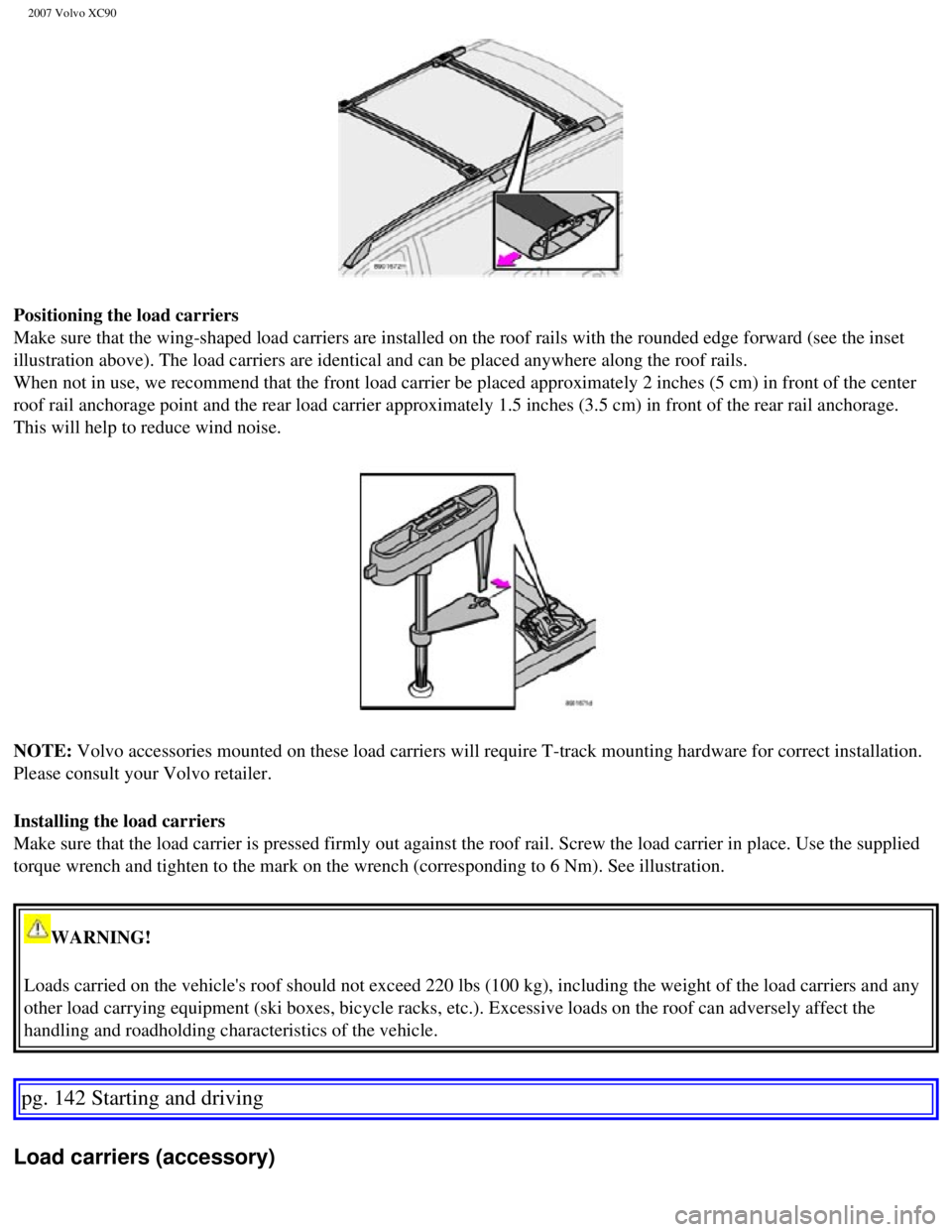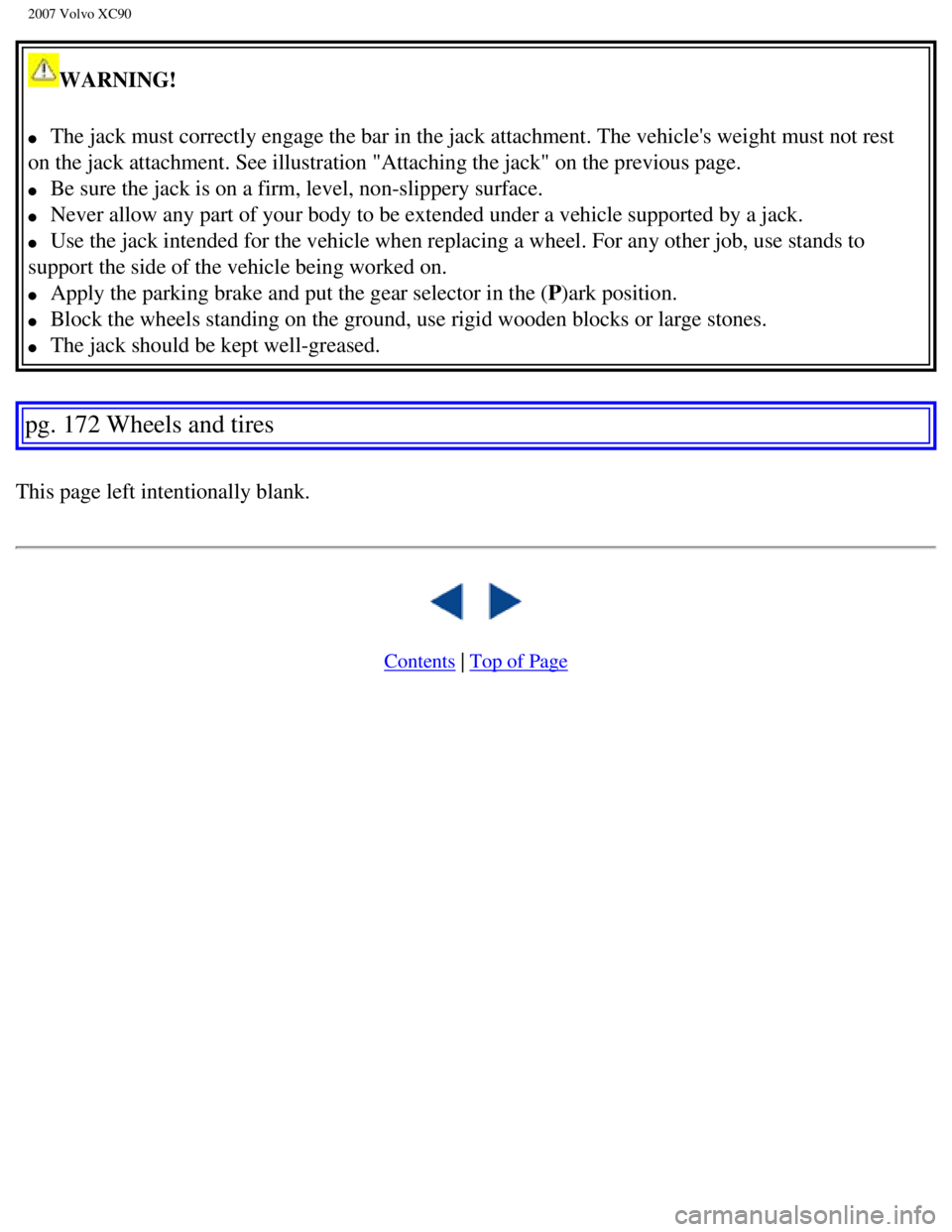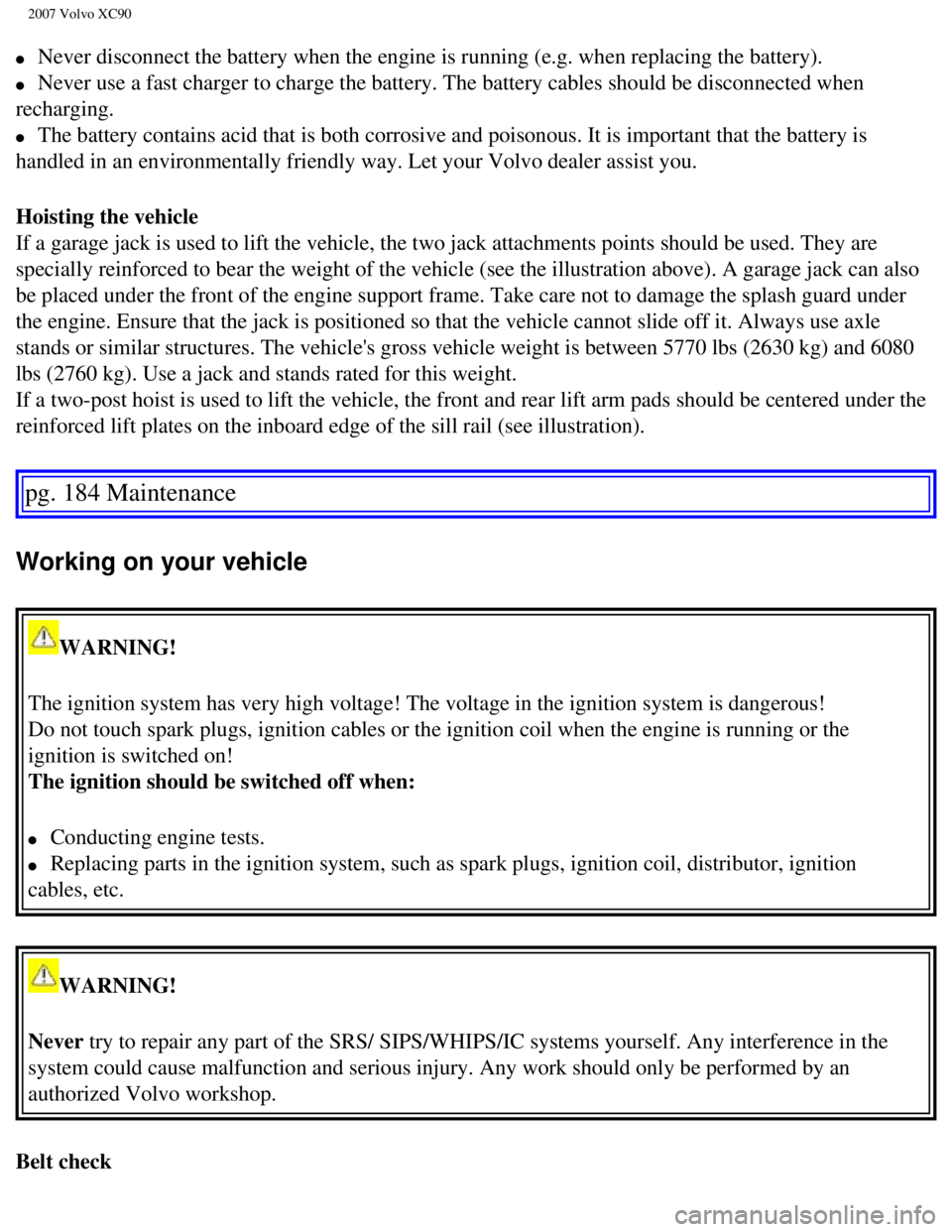weight VOLVO XC90 2007 Owner's Manual
[x] Cancel search | Manufacturer: VOLVO, Model Year: 2007, Model line: XC90, Model: VOLVO XC90 2007Pages: 268, PDF Size: 8.57 MB
Page 150 of 268

2007 Volvo XC90
Positioning the load carriers
Make sure that the wing-shaped load carriers are installed on the roof r\
ails with the rounded edge forward (see the inset
illustration above). The load carriers are identical and can be placed \
anywhere along the roof rails.
When not in use, we recommend that the front load carrier be placed appr\
oximately 2 inches (5 cm) in front of the center
roof rail anchorage point and the rear load carrier approximately 1.5 in\
ches (3.5 cm) in front of the rear rail anchorage.
This will help to reduce wind noise.
NOTE: Volvo accessories mounted on these load carriers will require T-track m\
ounting hardware for correct installation.
Please consult your Volvo retailer.
Installing the load carriers
Make sure that the load carrier is pressed firmly out against the roof r\
ail. Screw the load carrier in place. Use the supplied
torque wrench and tighten to the mark on the wrench (corresponding to 6\
Nm). See illustration.
WARNING!
Loads carried on the vehicle's roof should not exceed 220 lbs (100 kg)\
, including the weight of the load carriers and any
other load carrying equipment (ski boxes, bicycle racks, etc.). Excess\
ive loads on the roof can adversely affect the
handling and roadholding characteristics of the vehicle.
pg. 142 Starting and driving
Load carriers (accessory)
file:///K|/ownersdocs/2007/2007_XC90/07xc90_06.htm (26 of 32)12/30/200\
6 5:53:44 PM
Page 168 of 268

2007 Volvo XC90
pg. 160 Wheels and tires
Glossary of tire terminology
l Tire information placard: A placard showing the OE (Original Equipment) tire sizes, recommende\
d
inflation pressure, and the maximum weight the vehicle can carry.
l Tire Identification Number (TIN): A number on the sidewall of each tire providing information
about the tire brand and manufacturing plant, tire size and date of manu\
facturer.
l Inflation pressure: A measure of the amount of air in a tire.
l Standard load: A class of P-metric or Metric tires designed to carry a maximum load a\
t 35 psi [37
psi (2.5 bar) for Metric tires]. Increasing the inflation pressure bey\
ond this pressure will not increase the
tires load carrying capability.
l Extra load: A class of P-metric or Metric tires designed to carry a heavier maximu\
m load at 41 psi
[43 psi (2.9 bar) for Metric tires]. Increasing the inflation pressure\
beyond this pressure will not increase
the tires load carrying capability.
l kPa: Kilopascal, a metric unit of air pressure.
l PSI: Pounds per square inch, a standard unit of air pressure.
l B-pillar: The structural member at the side of the vehicle behind the front door\
.
l Bead area of the tire: Area of the tire next to the rim.
l Sidewall of the tire: Area between the bead area and the tread.
l Tread area of the tire: Area of the perimeter of the tire that contacts the road when mounted \
on the
vehicle.
l Rim: The metal support (wheel) for a tire or a tire and tube assembly upo\
n which the tire beads are
seated.
l Maximum load rating: a figure indicating the maximum load in pounds and kilograms that can \
be
carried by the tire. This rating is established by the tire manufacturer\
.
l Maximum permissible inflation pressure: the greatest amount of air pressure that should ever be
put in the tire. This limit is set by the tire manufacturer.
l Recommended tire inflation pressure: inflation pressure, established by Volvo, which is based on
the type of tires that are mounted on a vehicle at the factory. This inf\
lation pressure is affected by the
number of occupants in the vehicle, the amount of cargo, and the speed a\
t which the vehicle will be
driven for a prolonged period. This information can be found on the tire\
inflation placard(s) located on
the driver's side B-pillar or on the inside of the fuel filler door on C\
anadian models, and in the tire
inflation table in this chapter.
l Cold tires: The tires are considered to be cold when they have the same temperatur\
e as the
surrounding (ambient) air. This temperature is normally reached after \
the vehicle has been parked for at
least 3 hours.
pg. 161 Wheels and tires
Vehicle loading
file:///K|/ownersdocs/2007/2007_XC90/07xc90_07.htm (12 of 23)12/30/200\
6 5:53:47 PM
Page 169 of 268

2007 Volvo XC90
Properly loading your vehicle will provide maximum return of vehicle des\
ign performance.
Before loading your vehicle, familiarize yourself with the following ter\
ms for determining your vehicle's
weight ratings, with or without a trailer, from the vehicle's Federal/ C\
anadian Motor Vehicle Safety
Standards (FMVSS/CMVSS) label, and the vehicle's tire information plac\
ard.
Curb weight
The weight of the vehicle including a full tank of fuel and all standard\
equipment. It does not include
passengers, cargo, or optional equipment.
Capacity weight
All weight added to the curb weight, including cargo and optional equipm\
ent. When towing, trailer hitch
tongue load is also part of cargo weight.
NOTE: For trailer towing information, please refer to the section "Towing a t\
railer" on
page 137.
Permissible axle weight
The maximum allowable weight that can be carried by a single axle (fron\
t or rear). These numbers are
shown on the Federal/Canadian Motor Vehicle Safety Standards (FMVSS/ CM\
VSS) label. The total
load on each axle must never exceed its maximum permissible weight.
Gross vehicle weight (GVW)
The vehicle's curb weight + cargo + passengers.
NOTE:
l The location of the various labels in your vehicle can be found on page 208.
l A table listing important weight limits for your vehicle can be found on\
page 209.
Steps for Determining Correct Load Limit
- Locate the statement "the combined weight of occupants and cargo shoul\
d never exceed XXX pounds''
on your vehicle's placard.
- Determine the combined weight of the driver and passengers that will b\
e riding in your vehicle.
- Subtract the combined weight of the driver and passengers from XXX kil\
ograms or XXX pounds.
- The resulting figure equals the available amount of cargo and luggage \
load capacity. For example, if
the "XXX'' amount equals 1400 lbs. and there will be five 150 lb. passen\
gers in your vehicle, the amount
of available cargo and luggage load capacity is 650 lbs. (1400- 750 (5\
x 150) = 650 lbs.)
- Determine the combined weight of luggage and cargo being loaded on the\
vehicle. That weight may
not safely exceed the available cargo and luggage load capacity calculat\
ed in Step 4.
- If your vehicle will be towing a trailer, load from your trailer will \
be transferred to your vehicle.
Consult this manual
1 to determine how this reduces the available cargo and luggage load capa\
city of
your vehicle.
file:///K|/ownersdocs/2007/2007_XC90/07xc90_07.htm (13 of 23)12/30/200\
6 5:53:47 PM
Page 170 of 268

2007 Volvo XC90
1. See "Towing a trailer" on page 137.
pg. 162 Wheels and tires
Vehicle loading
WARNING!
l Exceeding the permissible axle weight, gross vehicle weight, or any othe\
r weight rating limits can
cause tire overheating resulting in permanent deformation or catastrophi\
c failure.
l Do not use replacement tires with lower load carrying capacities than th\
e tires that were original
equipment on the vehicle because this will lower the vehicle's GVW ratin\
g. Replacement tires with a
higher limit than the originals do not increase the vehicle's GVW rating\
limitations.
pg. 163 Wheels and tires
Uniform Tire Quality Grading
ALL PASSENGER VEHICLE TIRES MUST CONFORM TO FEDERAL SAFETY
REQUIREMENTS IN ADDITION TO THESE GRADES
Quality grades can be found, where applicable, on the tire sidewall betw\
een the tread shoulder
and maximum section width. For example:
Treadwear 200 Traction AA Temperature A
TREADWEAR
The treadwear grade is a comparative rating based on the wear rate of th\
e tire when tested under
controlled conditions on a specified government test course. For example\
, a tire graded 150 would wear
one and one half (1 1/2) times as well on the government course as a t\
ire graded 100. The relative
performance of tires depends upon the actual conditions of their use, ho\
wever, and many depart
significantly from the norm due to variation in driving habits, maintena\
nce practices and differences in
road characteristics and climate.
TRACTION
The traction grades, from highest to lowest, are AA, A, B, and C, as mea\
sured under controlled
conditions on specified government test surfaces of asphalt and concrete\
. A tire marked C may have
poor traction performance.
file:///K|/ownersdocs/2007/2007_XC90/07xc90_07.htm (14 of 23)12/30/200\
6 5:53:47 PM
Page 179 of 268

2007 Volvo XC90
WARNING!
l The jack must correctly engage the bar in the jack attachment. The vehic\
le's weight must not rest
on the jack attachment. See illustration "Attaching the jack" on the pre\
vious page.
l Be sure the jack is on a firm, level, non-slippery surface.
l Never allow any part of your body to be extended under a vehicle support\
ed by a jack.
l Use the jack intended for the vehicle when replacing a wheel. For any ot\
her job, use stands to
support the side of the vehicle being worked on.
l Apply the parking brake and put the gear selector in the (P)ark position.
l Block the wheels standing on the ground, use rigid wooden blocks or larg\
e stones.
l The jack should be kept well-greased.
pg. 172 Wheels and tires
This page left intentionally blank.
Contents | Top of Page
file:///K|/ownersdocs/2007/2007_XC90/07xc90_07.htm (23 of 23)12/30/200\
6 5:53:47 PM
Page 191 of 268

2007 Volvo XC90
l Never disconnect the battery when the engine is running (e.g. when repl\
acing the battery).
l Never use a fast charger to charge the battery. The battery cables shoul\
d be disconnected when
recharging.
l The battery contains acid that is both corrosive and poisonous. It is im\
portant that the battery is
handled in an environmentally friendly way. Let your Volvo dealer assist\
you.
Hoisting the vehicle
If a garage jack is used to lift the vehicle, the two jack attachments p\
oints should be used. They are
specially reinforced to bear the weight of the vehicle (see the illustr\
ation above). A garage jack can also
be placed under the front of the engine support frame. Take care not to \
damage the splash guard under
the engine. Ensure that the jack is positioned so that the vehicle canno\
t slide off it. Always use axle
stands or similar structures. The vehicle's gross vehicle weight is betw\
een 5770 lbs (2630 kg) and 6080
lbs (2760 kg). Use a jack and stands rated for this weight.
If a two-post hoist is used to lift the vehicle, the front and rear lift\
arm pads should be centered under the
reinforced lift plates on the inboard edge of the sill rail (see illust\
ration).
pg. 184 Maintenance
Working on your vehicle
WARNING!
The ignition system has very high voltage! The voltage in the ignition s\
ystem is dangerous!
Do not touch spark plugs, ignition cables or the ignition coil when the \
engine is running or the
ignition is switched on!
The ignition should be switched off when:
l Conducting engine tests.
l Replacing parts in the ignition system, such as spark plugs, ignition co\
il, distributor, ignition
cables, etc.
WARNING!
Never try to repair any part of the SRS/ SIPS/WHIPS/IC systems yourself. Any \
interference in the
system could cause malfunction and serious injury. Any work should only \
be performed by an
authorized Volvo workshop.
Belt check
file:///K|/ownersdocs/2007/2007_XC90/07xc90_09.htm (5 of 37)12/30/2006\
5:53:50 PM
Page 194 of 268

2007 Volvo XC90
Engine oil
Oil specifications
Engine oil must meet the minimum ILSAC specification GF-3, API SL, and A\
CEA A1/ B1. Lower
quality oils may not offer the same fuel economy, engine performance, or\
engine protection.
Volvo recommends
.
Depending on your driving habits, premium or synthetic oils may provide \
superior fuel economy and
engine protection. Consult your Volvo retailer for recommendations on pr\
emium or synthetic oils.
Oil additives must not be used.
NOTE: Synthetic oil is not used when the oil is changed at the normal mainten\
ance services. This oil is
only used at customer request, at additional charge. Please consult your\
Volvo retailer.
Oil viscosity (stable ambient temperatures)
Operation in hot climates
When temperatures exceed 86° F (30° C) in your area, Volvo recom\
mends, for the protection of your
engine, that you use a heavier weight oil, such as such as SAE 5W-40 or \
0W-40. See the viscosity chart.
Operation in temperate climates
Incorrect viscosity oil can shorten engine life. Under normal use when t\
emperatures do not exceed 86° F
(30° C), SAE 5W-30 will provide good fuel economy and engine protec\
tion. See the viscosity chart.
Extreme engine operation
Synthetic oils meeting SAE 0W-30 or 0W-40 and complying with oil quality\
requirements are
recommended for driving in areas of sustained temperature extremes (hot\
or cold), when towing a trailer
over long distances, and for prolonged driving in mountainous areas.
file:///K|/ownersdocs/2007/2007_XC90/07xc90_09.htm (8 of 37)12/30/2006\
5:53:50 PM
Page 224 of 268

2007 Volvo XC90
2 0 0 7
VOLVO XC90
Specifications
pg. 207 Specifications
Label information
208
Weights
209
Dimensions
210
Bulbs
211
Engine oil
212
Fluid specifications and
capacities
213
Suspension
213
Three-way catalytic converter
215
Electrical system
216
Engine specifications
217
Volvo programs
218
All specifications are subject to change without prior notice.
pg. 208 Specifications
Label information
file:///K|/ownersdocs/2007/2007_XC90/07xc90_10.htm (1 of 10)12/30/2006\
5:53:52 PM
Page 226 of 268

2007 Volvo XC90
1. Not on vehicles equipped with the optional power child safety locks. \
pg. 209 Specifications
Weights
Gross vehicle weight1 USA
Canada
5-seat, 6-cyl, FWD 5750
lbs -
5-seat, 6-cyl, AWD 5900
lbs 2680 kg
5-seat, 8-cyl, AWD 5900
lbs 2680 kg
7-seat, 6-cyl, FWD 5915
lbs -
7-seat, 6-cyl, AWD 6080
lbs 2760 kg
7-seat, 8-cyl, AWD 6100
lbs 2770 kg
Capacity weight
5-seat models 1160
lbs 525 kg
7-seat models 1210
lbs 550 kg
Permissible axle weight,
front*
5-seat, 6-cyl, FWD 770 lbs -
5-seat, 6-cyl, AWD 2880
lbs 1310 kg
5-seat, 8-cyl, AWD 2930
lbs 1330 kg
7-seat, 6-cyl, FWD 2770
lbs -
7-seat, 6-cyl, AWD 2880
lbs 1310 kg
file:///K|/ownersdocs/2007/2007_XC90/07xc90_10.htm (3 of 10)12/30/2006\
5:53:52 PM
Page 227 of 268

2007 Volvo XC90
7-seat, 8-cyl, AWD 2930
lbs 1330 kg
1. Permissible axle weight or gross vehicle weight must never be exceede\
d.
Permissible axle weight,
rear
1 USA
Canada
5-seat, 6-cyl, FWD 3060 lbs -
5-seat, 6-cyl, AWD 3150 lbs 1430 kg
5-seat, 8-cyl, AWD 3150 lbs 1430 kg
7-seat, 6-cyl, FWD 3170 lbs -
7-seat, 6-cyl, AWD 3240 lbs 1470 kg
7-seat, 8-cyl, AWD 3240 lbs 1470 kg
Curb weight
5-seat, FWD 4290-4400
lbs -
5-seat, AWD 4420-4655
lbs 2020-2130 kg
7-seat, FWD 4475-4570
lbs -
7-seat, AWD 4605-4820
lbs 2110-2160 kg
Max. roof load 220 lbs 100 kg
Trailer weight, w/o brakes 1650 lbs 750 kg
Trailer weights, with brakes See the table on
page 137
Max. tongue weight See the table on
page 137
WARNING!
When adding accessories, equipment, luggage and other cargo to your vehi\
cle, the total capacity
weight must not be exceeded.
pg. 210 Specifications
file:///K|/ownersdocs/2007/2007_XC90/07xc90_10.htm (4 of 10)12/30/2006\
5:53:52 PM